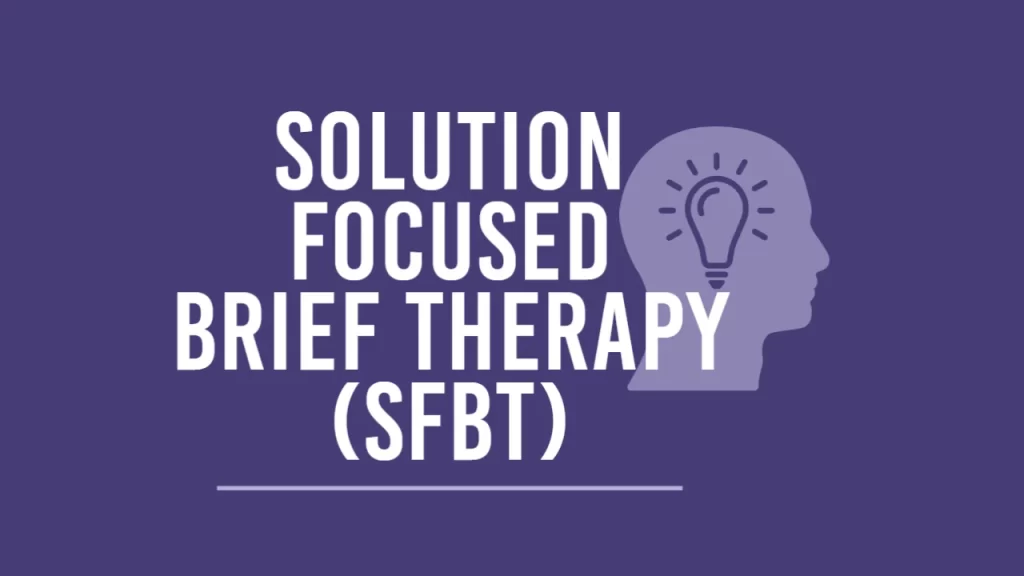
Solution-Focused Brief Therapy or SFBT is counseling – it is a type of psychotherapy honed through years of expert field experience. You may be wondering at this point what is so special about this particular psychotherapy. And whether solution-focused brief therapy for anxiety is worth a shot.
What makes a solution-focused brief therapy session different? While most other psychotherapies focus largely on the problem at hand, SFBT focuses on the strengths that the client has. This is what makes SFBT stand out from the rest.
Traditional talking therapies devote a lot of time to understanding how the adverse situation arose in the first place. SFBT on the other hand, prioritizes the solution to the problem and how to move forward instead of looking backward to resolve the issue in question.
SFBT – A Brief History

This talking therapy came about in the late 70s courtesy of De Shazer and Berg at the Brief Family Therapy Center. Berg and De Shazer formulated this methodology when they noticed that clients were often unaware of their inner strengths. These personal assets are vital for overcoming problems of all sorts. The duo also took note of how clients would focus on the past while giving very little thought to the future. To address and resolve these widely prevalent shortcomings, Berg and De Shazer came up with SFBT.
Berg and De Shazer were also concerned about one frequently occurring fact. Most, if not all clients, were able to live well for years without having to contend with the problem. This suggested to the two therapists that clients have the inner strength or resources necessary to conquer their problems. For how else were they able to live so long without these problems in the first place?
What SFBT Can Do for You
SFBT can treat various mood, emotional, and mental issues like
- Anxiety
- Depression
- Addiction or substance abuse
- Work-related anxiety or stress
- Personal anxiety or stress
- Low self-esteem
- Relationship issues
SFBT is a tried and tested technique that helps clients reach their goals and resolve pressing problems.
On the other hand, SFBT (on its own) is less feasible for very serious mental conditions like schizophrenia and psychosis. In such cases, it is vital to use SFBT in conjunction with psychiatry.
SFBT is a very useful adjunct to psychiatry since it draws upon the internal strengths of the client to combat severe mental health conditions. It pays to help clients focus on their inner strengths that they often possess in abundance but are unaware of. The strength, resilience, and tenacity of the human mind cannot be denied. SFBT builds upon this key fact.
SFBT – Here’s What the Science Says

Certain studies (like Maljanen, et al., 2012) indicate that SFBT proved effective in significantly alleviating mood disorders such as anxiety and depression one year after the SFBT treatment ended. Remember, that SFBT techniques were used for serious disorders in tandem with psychiatry.
Another study (Kim, Brook, & Akin, 2018) indicates that SFBT was no less effective than other talking therapies for alleviating addiction as well as trauma.
One literature review (Bond et al. 2013) shows that SFBT is an effective solution for resolving problematic child behaviors. There is one caveat though. The treatment should be administered in the early stages before these behavioral problems become deeply entrenched and severe.
Hence, solution-focused brief therapy for anxiety is a science-backed intervention. A solution-focused brief therapy session may be for your issues.
Techniques Used in Solution-Focused Brief Therapy

In the SFBT paradigm, the practitioner collaborates with the client to establish goals and to find solutions for reaching these goals. Likewise, the practitioner will identify problems in partnership with the client, and together, they figure out how to resolve these problems.
In short, the focus is on a collaborative approach since active participation by the client works wonders. It can boost client commitment, and thus improve the chances of successful outcomes. This is a key tactic deployed in solution-focused brief therapy for anxiety.
Here are some techniques that a solution-focused brief therapy session entails.
Miracle Question
The expert requests the client to perform the following thought experiment: imagine you wake up the next morning and the problem has vanished suddenly without a trace.
The practitioner will question the client on how they will feel different in such a scenario and how they can be certain that the problem has indeed vanished.
The point of asking such questions is to help clients understand the problem better and to reflect on the effects it is having on them. More importantly, by encouraging clients to imagine what it would be like to live without the problem, practitioners hope to provide a powerful motivation that will strengthen their resolve to overcome their issues.
Coping Questions
Practitioners inquire from clients how they manage to cope with their problems. After all, they have lived for so long with this problem. How did they manage to come this far despite the problem? Such questions remind the client that they already possess the inner strength to move forward in their lives despite their intense issues.
Exceptions to the Problem
The problem develops at some point in the client’s life. This means that the client lived for a time without the problem affecting them. There is quite often a period during which the problem does not have serious repercussions despite being present.
The practitioner asks what it was like to live without the problem. This is to remind clients that there was a time when they did not face this problem. Clients realize that they have the strength within to cope with this problem and eliminate it. It can be quite empowering for clients to realize that they spent a significant part of their lives without the problem. And that they can live without the problem in the future if they choose to.
Compliments
The wise practitioner should question what the client did to resolve the issue. Usually, the client will have done something that at the very least yielded some positive result for a limited period.
The practitioner should lavish praise even for the smallest and most transient success. To have the client believe they have what it takes to overcome their problems. The smallest encouragement can go a long way toward building client confidence.
Scale or Rating System
To evaluate the severity of the problem or the level of success, the practitioner can ask the client to provide a rating on a scale from one to ten. An example of this could be “On a scale of one to ten, tell me how strongly your anxiety has affected your work performance?”
Or it could be “On a scale of one to ten, how has this solution-focused brief therapy session elevated your mood?”
Such a rating system can provide some objectivity to the process. It can furnish crude estimates to the practitioner on how well solution-focused brief therapy for anxiety is progressing.
Final Thoughts
Solution-focused brief therapy for anxiety can be an effective intervention based on the pragmatic techniques mentioned above that were honed by practitioners based on their long experience in the field. Hence, you may consider solution-focused brief therapy sessions to resolve your issues and enrich your life.
